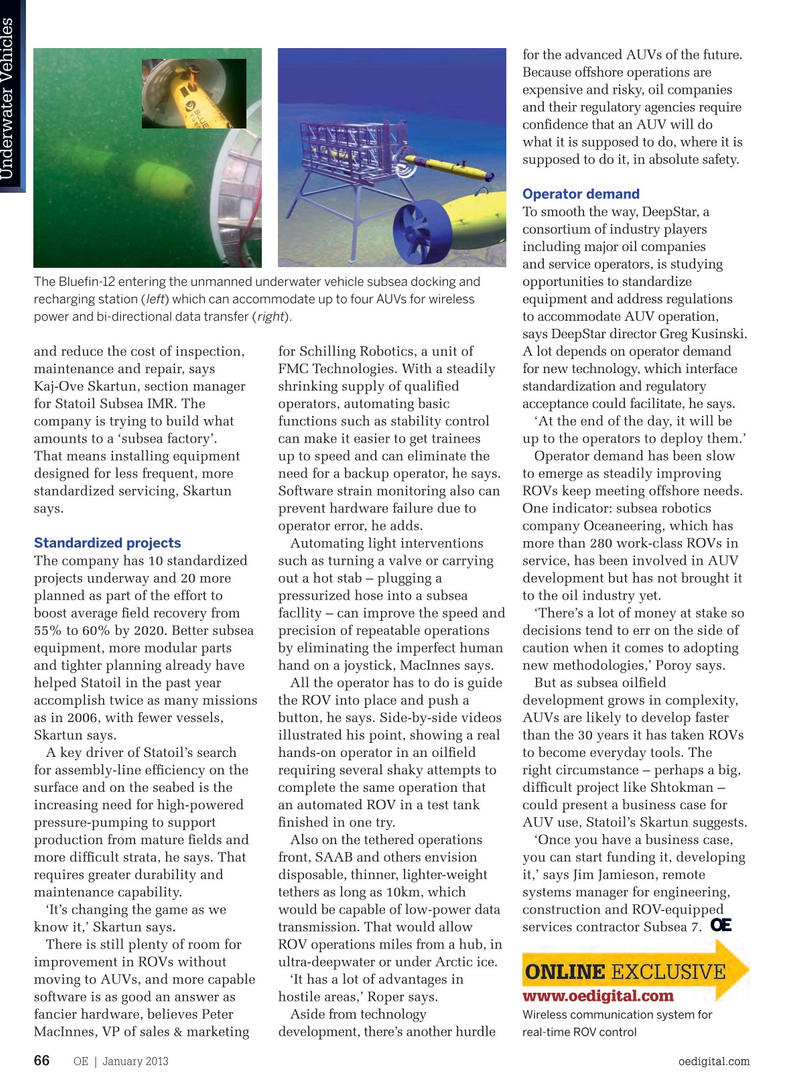
Page 64: of Offshore Engineer Magazine (Jan/Feb 2013)
Read this page in Pdf, Flash or Html5 edition of Jan/Feb 2013 Offshore Engineer Magazine
for the advanced AUVs of the future.
Because offshore operations are expensive and risky, oil companies and their regulatory agencies require con? dence that an AUV will do what it is supposed to do, where it is supposed to do it, in absolute safety.
Underwater Vehicles
Operator demand
To smooth the way, DeepStar, a consortium of industry players including major oil companies and service operators, is studying opportunities to standardize
The Blue? n-12 entering the unmanned underwater vehicle subsea docking and equipment and address regulations left recharging station ( ) which can accommodate up to four AUVs for wireless to accommodate AUV operation, right power and bi-directional data transfer ( ).
says DeepStar director Greg Kusinski. and reduce the cost of inspection, for Schilling Robotics, a unit of A lot depends on operator demand maintenance and repair, says FMC Technologies. With a steadily for new technology, which interface
Kaj-Ove Skartun, section manager shrinking supply of quali? ed standardization and regulatory for Statoil Subsea IMR. The operators, automating basic acceptance could facilitate, he says. company is trying to build what functions such as stability control ‘At the end of the day, it will be amounts to a ‘subsea factory’. can make it easier to get trainees up to the operators to deploy them.’
That means installing equipment up to speed and can eliminate the Operator demand has been slow designed for less frequent, more need for a backup operator, he says. to emerge as steadily improving standardized servicing, Skartun Software strain monitoring also can ROVs keep meeting offshore needs. says. prevent hardware failure due to One indicator: subsea robotics operator error, he adds. company Oceaneering, which has
Standardized projects Automating light interventions more than 280 work-class ROVs in
The company has 10 standardized such as turning a valve or carrying service, has been involved in AUV projects underway and 20 more out a hot stab – plugging a development but has not brought it planned as part of the effort to pressurized hose into a subsea to the oil industry yet. boost average ? eld recovery from facllity – can improve the speed and ‘There’s a lot of money at stake so 55% to 60% by 2020. Better subsea precision of repeatable operations decisions tend to err on the side of equipment, more modular parts by eliminating the imperfect human caution when it comes to adopting and tighter planning already have hand on a joystick, MacInnes says. new methodologies,’ Poroy says.
helped Statoil in the past year All the operator has to do is guide But as subsea oil? eld accomplish twice as many missions the ROV into place and push a development grows in complexity, as in 2006, with fewer vessels, button, he says. Side-by-side videos AUVs are likely to develop faster
Skartun says. illustrated his point, showing a real than the 30 years it has taken ROVs A key driver of Statoil’s search hands-on operator in an oil? eld to become everyday tools. The for assembly-line ef? ciency on the requiring several shaky attempts to right circumstance – perhaps a big, surface and on the seabed is the complete the same operation that dif? cult project like Shtokman – increasing need for high-powered an automated ROV in a test tank could present a business case for pressure-pumping to support ? nished in one try. AUV use, Statoil’s Skartun suggests.
production from mature ? elds and Also on the tethered operations ‘Once you have a business case, more dif? cult strata, he says. That front, SAAB and others envision you can start funding it, developing requires greater durability and disposable, thinner, lighter-weight it,’ says Jim Jamieson, remote maintenance capability. tethers as long as 10km, which systems manager for engineering, ‘It’s changing the game as we would be capable of low-power data construction and ROV-equipped know it,’ Skartun says. transmission. That would allow services contractor Subsea 7. There is still plenty of room for ROV operations miles from a hub, in improvement in ROVs without ultra-deepwater or under Arctic ice.
moving to AUVs, and more capable ‘It has a lot of advantages in software is as good an answer as hostile areas,’ Roper says.
www.oedigital.comwww.oedigital.com fancier hardware, believes Peter Aside from technology
Wireless communication system for
MacInnes, VP of sales & marketing development, there’s another hurdle real-time ROV control
OE | January 2013 oedigital.comoedigital.com 66 oe_AUVs3.indd 66 03/01/2013 13:48

 63
63

 65
65